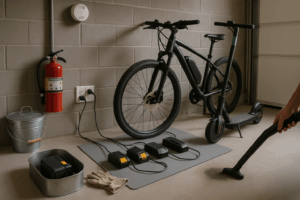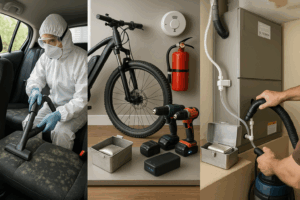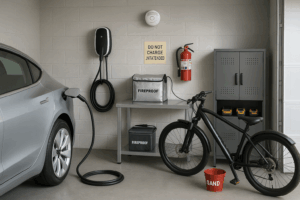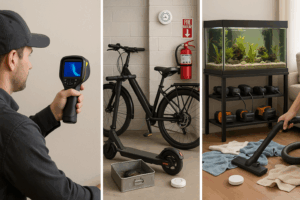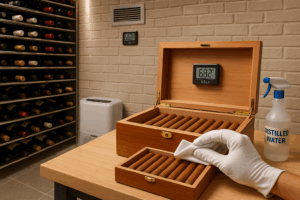Fire safety is one of the most overlooked yet absolutely necessary aspects of enjoying a home workshop or a DIY garage setup. For homeowners and passionate DIYers, nothing feels better than having a dedicated space for projects, tool storage, and creativity. However, those same garages and workshops hold hidden fire risks due to the mix of flammable materials, electrical tools, and storage challenges. Protecting your hobbies, safeguarding your investments, and keeping family safe starts with practical steps right inside the workspace.
Understanding Home Workshop Fire Risks
A home workshop seems safe on the surface. Power tools line the walls, wood shavings gather under the workbench, cans of paint line the shelves, and in the excitement of the next project, safety becomes an afterthought. Yet according to the U.S. Fire Administration, thousands of garage fires happen each year in residential homes. One and two-family homes are affected the most, often due to electrical malfunctions or poor storage practices. The losses add up in lives, injuries, and significant property damage.
Understanding risk factors is the first step toward real safety. The most common causes involve improperly stored gasoline, paint thinners, or propane. Mixed with sparks from faulty tools, overloaded power strips, or clutter blocking the exits, even a small mistake can become a dangerous fire. Recognizing what raises the risk inside your own workspace can help you fix the weak points before a problem arises.
Common Fire Hazards in Workshops and Garages
Every home workshop stores a unique variety of materials and equipment, but many households share similar hazards. Gasoline for lawnmowers and generators creates a persistent fire threat. Paints, varnishes, and propane canisters must be stored safely but often end up on crowded shelves or left near where sparks fly. Sawdust and wood shavings, although seemingly harmless, are also highly combustible and can help a small fire escalate quickly.
Faulty or overloaded electrical setups remain a leading cause of home workshop fires. Multiple charging tools plugged into overloaded outlets, old wiring, or even daily use of extension cords for heavy appliances puts stress on the system. Temporary fixes like daisy-chained power strips or using extension cords for permanent power create fire hazards. With many older garages and basements not upgraded to current electrical codes, a hidden risk might be waiting behind the walls.
Clutter, a silent issue, provides fuel for any fire that starts. Old rags soaked with chemicals, stacked cardboard boxes, or piles of scrap wood make it harder to move quickly in an emergency. Cluttered spaces also block exits, making escape difficult if a fire breaks out.
Safe Storage for Flammable Materials
Effective fire prevention begins with storage. Never store gasoline, propane, paint thinners, or cleaning chemicals inside your main home if you can avoid it. Use approved, tightly sealed containers and keep these substances in a detached shed or a ventilated, isolated section of your garage. If keeping them outside is not realistic, place them in heavy-duty storage cabinets that limit air exposure and minimize vapor buildup.
Paints, varnishes, and oils require special care. Once opened, these containers may release flammable fumes. Store them away from direct sunlight, heat sources, or any area where tools might create sparks. Clean up leaks or spills immediately and dispose of soaked rags in metal containers with tight-fitting lids. Consider buying only as much as you’ll use for your current project to reduce the volume of stored chemicals over time.
Label all containers clearly. Teach everyone who uses the space, including teenagers in the family, what the labels mean and how to handle these materials carefully. Reduce how many flammable items are present at any given time in your workspace.
Electrical Safety Best Practices
Safe electrical systems form the backbone of any home workshop or DIY garage. Old wiring or outlets not designed for heavy use pose a real risk. You should plug only a single charging tool or device into each outlet at one time to prevent overheating. Avoid using extension cords for permanent equipment or for charging battery-powered tools. Cords are designed for temporary load only.
If you find yourself constantly juggling plugs or using multiple power strips, it may be time to consult a licensed electrician and upgrade your service. Have them inspect all outlets, switches, and wiring. Ask about ground fault circuit interrupters, which shut power off instantly when a problem is detected. These are recommended in garages, basements, and workshops.
Inspect cables before each use. Replace anything that is frayed or damaged. Keep power cords away from puddles, water leaks, or areas where they might be pinched or crushed. Never leave chargers plugged in when not in use, especially overnight. Permanently mount power strips above the workbench, away from flammable materials, and avoid coiling cords tightly, which can make them overheat faster.
Keeping the Workspace Organized
An organized home workshop dramatically reduces fire risks. Every tool, piece of scrap wood, or can of solvent has its place. Cluttered workbenches are not just messy, they are dangerous. Sawdust ignites quickly, especially near electrical tools. Rags used for oil or staining must be stored in sealed metal bins, not left heaped in a corner.
Establish clear zones for storage, active projects, and trash. Sweep frequently, and dispose of sawdust, packaging, and debris at the end of each project session. Arrange larger items and backup equipment to avoid blocking windows or doors. Maintain at least one clear, unobstructed escape route from any point in the garage or workshop to the outside of your home. Practicing this habit allows for a faster response if something catches fire.
Use closed cabinets or ventilated lockers for chemicals and flammable liquids. Store heavy or powered tools off the floor, away from where gasoline or chemical vapors might settle. If you have pets or young children, keep these cabinets locked or out of reach for extra safety.
Choosing the Right Alarms for Garages
Many homeowners assume smoke detectors are appropriate for every room. In a garage or workshop, dust and fumes can trigger frequent false alarms. Instead, install a heat alarm, which sounds when the temperature suddenly rises dangerously high, a clear sign of a fire. These alarms are specifically engineered for tough environments like workshops.
Proper placement matters. Mount heat alarms near the ceiling, away from windows or outside doors where temperatures can change abruptly. Test them several times a year, especially after any major workshop cleaning or renovation. Replace batteries on a regular schedule, even if the unit does not indicate a low battery yet. Teach everyone in the household what the alarm sounds like and what to do if it activates.
Carbon monoxide alarms are critical if you use fuel-burning equipment such as generators, propane heaters, or gas-powered tools. Install these close to the equipment, and check their batteries often. Carbon monoxide is odorless and deadly, making alarms absolutely necessary for family safety.
Fire-Resistant Construction for Safer Spaces
If you’re in the planning stage for a new garage or renovating an existing workspace, consider fire-resistant building features. Install a solid, self-closing, fire-rated door between your garage and any shared living space. This kind of door keeps flames and smoke from spreading into the main part of the home, giving you additional time in an emergency.
For garages with rooms above them, install specialized Type X gypsum board on the ceiling. This thicker wallboard delays the spread of fire upward, protecting anyone in the rooms above and minimizing total property damage. Use standard gypsum board on all connecting walls between the garage and the house. Check building codes in your area to see what’s required for maximum protection.
Essential Fire Safety Equipment Every Workshop Needs
No home workshop or garage is complete without an accessible, properly rated fire extinguisher. Select a model designed for use on both flammable liquids and electrical fires. Store it where it can be reached quickly and where it won’t be blocked by equipment or clutter. Teach every frequent user of the space how to operate the extinguisher. Practice regularly, especially if tools or shop layout change.
Keep an additional extinguisher in a separate area of the garage if possible, particularly in larger workspaces. Mount extinguishers on walls in clear view, well-marked and away from direct heat sources or chemicals. Check pressure levels and expiration dates on a consistent basis. Replace or recharge as necessary.
Install carbon monoxide alarms as described above if fuel-powered equipment is present. Emergency lighting, such as LED battery-powered lights, can help light exits if power is cut during a fire. Clearly mark all exits, and consider painting a line along the floor for low visibility situations.
Emergency Planning and Safe Responses
Preparation for fire starts long before you ever see smoke. Every family member or garage user should know how to shut off power at the breaker panel. Teach household members what to do if a fire alarm sounds, including how to leave the building quickly and where to meet outside at a safe distance. Practice exit drills twice a year, paying special attention to clearing clutter and keeping doors accessible.
If a fire starts and you cannot safely extinguish it, leave immediately. Never go back inside to save tools or equipment. Close doors behind you if possible to slow the fire, then call 911 right away. Once everyone is safe, wait for emergency responders and follow their advice.
Post-Fire Recovery: Salvaging Projects and Tools
If you face a fire, the loss feels overwhelming, especially for those invested in personal projects or expensive tools. Safety comes first. Do not enter the area until fire officials declare it safe. Once cleared to enter, document the condition of tools, materials, and ongoing projects for insurance claims.
Begin by sorting salvageable from irreparably damaged tools. Some hand and power tools can survive a fire with professional cleaning, decontamination, and repair. Remove any devices that might retain fumes or toxic chemicals. Use gloves, protective masks, and clothing while cleaning to avoid skin contact with soot, ash, or residue chemicals left from fire extinguishers.
Professional restoration services can clean and repair valuable tools, clean up soot or ash, and restore your workspace to safe conditions. This includes neutralizing toxic residues, drying out water-logged equipment, and ensuring air quality is safe before you resume work.
For DIYers who want to save what they can, take the time to inspect each item. Power tools exposed to direct flames may have compromised wiring or insulation. Hand tools, especially those with wooden handles, need to be checked for structural damage or splintering. Electronics or chargers that appear undamaged should be tested before use, preferably by a qualified repair shop.
Always discard any items that have absorbed chemicals, as unseen damage may make them unsafe. Wash everything that is saved thoroughly, and store restored tools in a clean, dry environment until the workspace is fully repaired.
Preventing Future Incidents With Smarter Safety Habits
After recovering from a fire, use the experience to reinforce new habits. Repair or upgrade all fire safety equipment regularly, and reassess your storage methods. Keep clutter at bay with monthly cleaning sessions. Replace dangerous or outdated wiring, and staple down new safety protocols. Share your lessons with other DIYers and those in your community, making fire safety an everyday priority.
Smart workshop design and routine maintenance are the best shields against fire. Make safety the heart of every project, and protect your family, workspace, and cherished tools for years to come.
For expert assistance with fire restoration or to help safeguard your own workshop from hazards, contact a trusted specialist such as All Nation Restoration for a professional review and reliable solutions.

